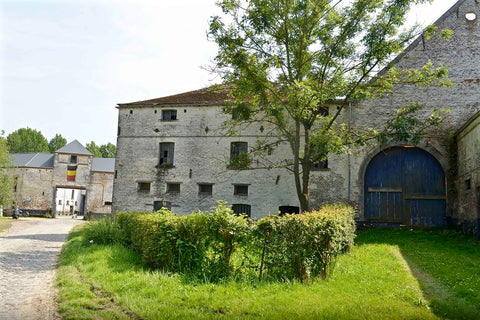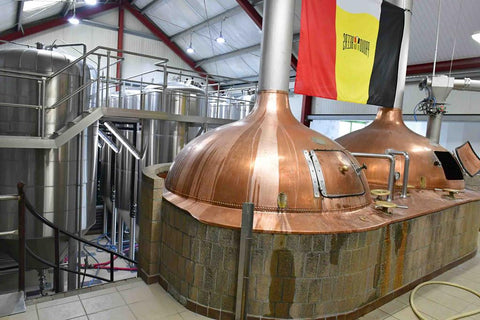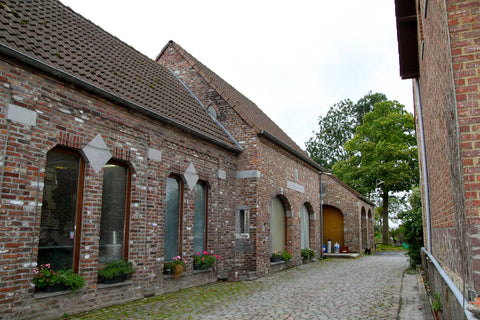- No products in the cart.
Brasserie de l'Abbaye du Val-Dieu

The Beginning – The Abbey of Val-Dieu celebrated its 800th anniversary in 2016. This abbey survived the French Revolution and was home to Cistercian monks until 2001. A Christian community living by the rules of St. Benedict is now based at the abbey.
Let’s go back in time and look at the origins of Val-Dieu. It was founded in 1216 by Cistercian monks from the Dutch village of Hocht, on lands donated by the Duke of Limburg and the Count of Dalhem.
Through sheer hard labour the monks managed to transform the inhospitable ‘devil’s valley’ of the river Berwinne into fertile arable land, naming it the ‘valley of the gods’ or Val-Dieu.
However, fate intervened in 1286, when the abbey was burned to the ground. In the 15th century the monastic community suffered greatly from the high taxes imposed during the reign of Charles the Bold. It would also suffer enormously during the religious wars under the Spanish occupation…
Val-Dieu was once again razed by Calvinist troops in 1574. It was rescued in 1640 by Abbot Simon Ranst. He succeeded in proving that the abbey was located in what was then the Duchy of Limburg, and thus fell under the firm stewardship of the Catholic King of Spain.
The architect Jean Dubois completed major building works on the site in the 18th century. All of the current abbey buildings standing today date back to that period.
Soon after the French Revolution, Abbot Jacques Uls repurchased the abbey.
However, after he passed away, Val-Dieu took on a different purpose: it was converted into a linen factory and a boarding school. The church was decommissioned in 1837 and the abbey was ransacked soon after. Three years later, Canon Henrotte and Abbot Burgers purchased the dilapidated property and a new religious community was born. In 1934 the church spire was replaced with the current copper tower.
Throughout the years Val-Dieu has been a steadfast symbol of peace and contemplation. This is borne out by its motto: ‘In Vinculo Pacis’ or ‘in the bond of peace’, symbolised by the two rings that are displayed everywhere, including on the Abbey’s bottle labels and the beer glasses.
The renovation of the current abbey grounds commenced in 1940 and heralded the end of the historic brewery.
Between 1975 and 1980 the tripel was brewed under licence by Van Steenberge whereas Piron, a beer trader from a nearby industrial estate, was responsible for brewing both the blonde and the dark Val-Dieu between 1993 and 1995.
In 1997 brewer Benoît Humblet and milk trader Alain Pelsser established the modern brewery in the former farm buildings on the abbey site. Val-Dieu’s annual production is now approx. 900,000 litres. The tripel and the grand cru are especially popular abroad, with exports going to the Netherlands, Russia, the USA, China and many other countries.
The Brewing

The Val-Dieu abbey beers were inspired by the brewing traditions of the monks. For many centuries beer was a trusted alternative to the not-very-reliable drinking water that caused illnesses such as cholera. Throughout the years, monks have greatly enhanced our knowledge of the brewing process.
Their know-how was translated into recipes that inspire brewers up to this day.
A characteristic of the Val-Dieu beers is their use of soft water. Unlike most abbeys, the monks here do not source their water from a well or spring, but from Lake Gileppe, a freshwater, artificial lake.
It is worth knowing that this area is renowned for the quality of its water, and is home to the well-known springs at Spa (the original spa resort), Bru and Chaudfontaine. All of these are within a 30-kilometre radius from the abbey.
The abbey’s top-fermented beers are created using the traditional infusion method, where warm water is gradually added to the mash until the desired 75°C temperature is achieved. At this point, the starch is released, which in the next stage will be converted into sugars that will feed the yeast. No herbs or other aromatics are added to the mother beers: blond, dark and tripel.
The beers will then undergo their main fermentation using a house yeast that is cultivated within the brewery. This yeast typically gives fruity aromas, often with a hint of banana.
All Val-Dieu beers re-ferment in the bottle. For re-fermentation, a different yeast is used that does not affect either the aroma or the taste.
The beers are given plenty of time to develop their alcohol volume as well as their complex taste and aromas. The entire production process takes six to eight weeks. The re-fermentation in the warm chamber alone, accounts for three weeks.
The Brewers

In 1997 brewing engineer Benoît Humblet and milk trader Alain Pelsser set up the current family brewery on the abbey site. For many years, both milk and beer were sent off to clients. Since then, Benoît has left the company to set up the Bertinchamps microbrewery in Gembloux. The Val-Dieu brewery is now 100% owned by Alain Pelsser and his nephew.
Val-Dieu is one of those rare abbeys where beer is still brewed on site. Around 200,000 people visit the abbey each year, with one in 10 of them also taking a look around the compact brewery, where you can watch the production process from start to finish.
These days the mash staff is wielded by brewing engineer Virginie Harzé ably assisted by Jonathan Petrenko. Virginie gained her first professional experience in the laboratories of the former Union brewery in Jumet. Respect for tradition and quality are paramount at Val-Dieu.
For example, the brewer uses only natural ingredients and all beers re-ferment in the bottle just like they used to. The Val-Dieu beers stand out for their aromatic character; bitterness takes second place. The beers’ aroma and taste have been consistent throughout the years.
The only recipe that has ever been adjusted is that of the dark Val-Dieu, where the touches of caramel are less dominant than before.
The Beers
The Visit

The history of Val-Dieu and its buildings is rooted in the 17th and 18th century. Visit the site and you will see monumental buildings steeped in the particular Renaissance style of the Maasland region, with influences from Roman and Gothic architecture.
The abbey church with its pointed campanile, or bell tower, draws the attention straight away. The church itself is a haven of peace and quiet, expressed through the ‘In vinculo pacis’ double-ringed symbol that can be seen everywhere.
This quiet atmosphere also reigns in the corridors of the abbey and throughout its enclosed interior court.
You can also visit the handsome boardroom, where major decisions affecting the community were made, as well as the large 17th century refectory.
Also, don't miss the library and two small salons or sitting rooms where handsome frescos are waiting to be admired.
Behind the abbey you will find an extensive 19th century garden including a fine arboretum with some rare varieties of tree. Wind your way back to the main courtyard, and you will find the brewery in a wing of the building just opposite the church.
If you want a quick and easy overview of the beer production process, you are in the right place, as the site is compact and well laid out.
Take the opportunity, before or after your visit, to taste the abbey beers accompanied by characteristic regional dishes in La Casse-Croûte. This is the abbey’s own restaurant, located in the former stables.
Across the road from the abbey you will find the old water mill, which is also now home to a restaurant. This restaurant offers a great view of the mill workings and also provides a large garden with terrace.
The Location

Val-Dieu is located in the heart of the Land of Herve, a paradise for both walkers and cyclists. The abbey is the starting point for a number of sign-posted cycle tracks and car tours (25-40 km), allowing you to discover the charms of this slightly undulating, green agricultural region steeped in a rich history.
Herve is a region of peaceful villages and quiet little towns with splendid vistas across green valleys and vast orchards that are typical of this fruit-growing area.
Now and again you will come across traces of the First World War, which has made its impact felt in this area in the shape of forts and monuments – the Battle of Liege, just to the south of the Land of Herve was the first big land engagement of that war.
Cyclists should come prepared for some climbing but, if you prefer pedalling on the flat, we can recommend the RaVel bike trails that follow ancient railway tracks and towpaths.
A highlight is the RaVel route that follows the old number 38 railway line and takes you past the former Herve railway station, now converted into a tourist office. Le Quai des Champs restaurant at the former station is a good spot to sample the beers and dishes the Land of Herve has to offer.
Walkers will find plenty to explore in the vicinity of the abbey. There are several short walking trails (3-6 km)as well as a signposted walk through the town of Herve itself. Within the six boroughs of the Land of Herve there are walks and hikes ranging from 2km to 22km.
Getting There & Around

Val-Dieu is located about 125km from Brussels. By car, the journey will take 1.5 hours from Brussels and half-an-hour from Liège. From Brussels, take the E40 for Liège. Then change to the E25 towards Verviers, followed by the A27 Aubel-Battice road.
Val-Dieu is also within easy reach of nearby Maastricht in the Netherlands or the German cities of Aachen (Aken/Aix-la-Chapelle) (50km) and Cologne (Köln, Keulen) (120km).
Using public transport? First of all, you need to know that the bus only comes to the abbey on Sundays.
The train from Liège to Verviers will take 40 minutes. Catch the TEC-bus 738 into Aubel, a 45-minute ride, and after a 3.5km walk you will reach the abbey. Rent a bike in Aux Berges de La Bel, 500 metres from the abbey.
A visit to Val-Dieu is a perfect opportunity to explore nearby Liège too. This city oozes history and offers plenty of opportunities for sight-seeing. Must-sees include the Musée de la Vie Wallonne; the recently refurbished Curtius house that incorporates museums dedicated to archaeology, decorative arts, religious arts and weaponry; and the impressive Liège-Guillemins railway station designed by famous architect Santiago Calatrava.
The 12th-century metal baptismal font (probably) by Renier van Hoei in the Church of Saint Barthélémy is a piece of world heritage and a masterpiece of the local Mosan art style.
Behind the well-known Prince-Bishops’ Palace in the heart of city there is a labyrinth of ‘coteaux’ to explore. These are narrow alleyways and thoroughfares with steps, around the main Montagne de Bueren thoroughfare that gives splendid views across the city and the river Meuse.
In the Outremeuse area, on the other side of the river, you may come across the spirit of world-famous crime novelist, Georges Simenon. And don’t miss the adventures of Tchantches, Liège’s oldest citizen, in the eponymous puppet theatre.
Gastronomy, Food & More Beer
_681x1024.jpg?1412095569)
The Herve Société cheese dairy is a co-operative bringing together several producers from the region. The Society produces the Val-Dieu abbey cheeses. These include the Val-Dieu Grand Cru, ripened using the dark abbey beer, the Bouquet des Moines, the Bleu des Moines, the Casse-Croûte and the Val-Dieu abbey cheese as well as the well-known, zesty Herve cheese.
The strong aroma and the piquant flavour of the Herve cheese is thanks to the local grass and milk. The development of this cheese requires a particular type of bacterium (Bacterium linens) that is found in the local soil and the cheese ripening chambers. This microbe also helps to build the crust of this particular cheese.
Syrup is another product that is strongly associated with this traditional fruit-growing region. The freshly harvested apples and pears are boiled for hours in large copper kettles until the juices are very thick.
The fruit is then sieved and the thickened juices will be refined, cooled down and processed. The result is a thick syrup, resembling molasses, with a wide range of culinary uses. Enjoy it in a sandwich with Herve cheese, alongside Liège waffles or pancakes, in sauces with venison, with Liège ‘boulettes’ (meat balls) or a pork stew.
Beef lovers are in for yet another treat. They can look forward to a juicy steak from a Belgian white-blue, a variety of cattle famous for its muscular, meaty rump. You can see them contentedly grazing the meadows.
More Info
Tourist information for Pays de Herve:
Maison du Tourisme du Pays de Herve
Place de la Gare 1
B-4650 Herve
Tel: +32 (0) 87 69 36 70
Email: info@paysdeherve.be
Website: www.paysdeherve.be
Contact

Brasserie de l'Abbaye du Val-Dieu
Val-Dieu 225
B-4880 Aubel
Belgium
B-4880 Aubel
Belgium








